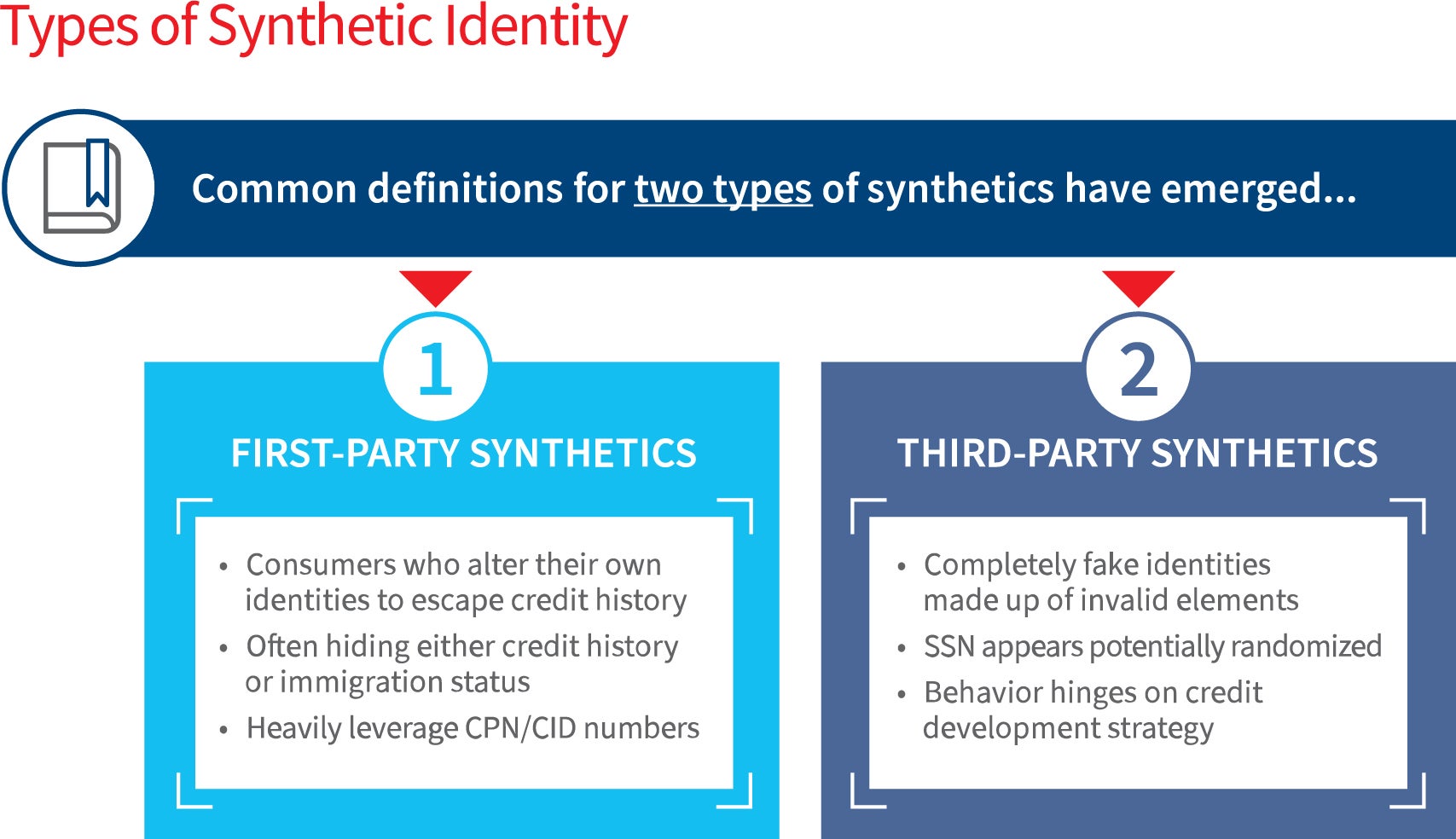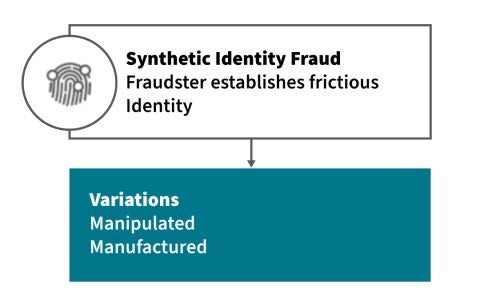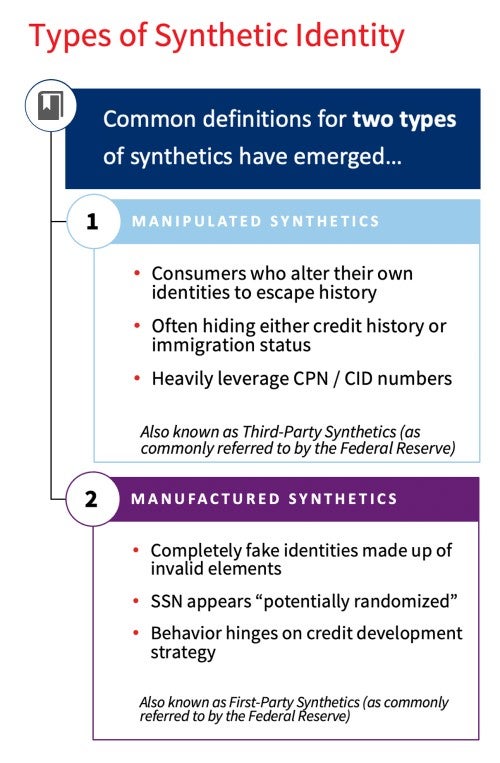
Pursue Portfolio Growth with More Confidence
Defend Against New Account Fraud Risk
Predictive scores and data attributes help detect new account fraud.
New account application fraud attacks against banks and other lending institutions are increasing in volume, sophistication and expense. The acceleration to digital transformation in recent years along with the abundance of stolen consumer PII data readily available on the dark web has greatly emboldened criminals. New technologies make it easier for them to be stealthy, flying beneath the radar of legacy risk management processes.
The statistics reveal a fast-growing problem. Fraud costs in digital channels for U.S. lenders increased 29% on average between 2021 and 2022.1
Banks and other lending institutions must quickly become more proactive and diligent in their application fraud prevention efforts, or they risk significant financial losses and reputational damage.
Fraud Intelligence helps detect and prevent new account acquisition fraud risk. Lenders gain a more holistic and powerful view of over 286 million identities living in the U.S. and U.S. territories by leveraging the LexisNexis® Inquiry Identity Network. Insights from vast and growing data assets and consortium feedback help to highlight identity fraud and support sustainable, scalable mitigation strategies.
Benefits
Help stop new account acquisition fraud.
The Fraud Intelligence solutions suite helps banks and other financial institutions to mitigate new account acquisition fraud risk while reducing friction for legitimate customers.
![]() Increase Profits
Increase Profits
Reduce financial losses by blocking fraudulent applications and keeping bad actors out of your portfolio via stronger account-opening fraud assessments.
![]() Improve Operational Efficiencies
Improve Operational Efficiencies
Reduce false positives to focus on higher-risk applications for more effective fraud investigations.
![]() Enhance the Customer Experience
Enhance the Customer Experience
Minimize unnecessary delays in approvals with robust identity trust for legitimate consumers and deliver a more positive customer experience.
Features
Powerful tools for fraud detection.
The Fraud Intelligence solutions suite integrates into existing workflows and risk strategies to defend against third-party fraud, synthetic identity fraud and first-party fraud at account origination:
Third-Party Scores
Examine 200+ indicators of fraud risk in consumer identity events and application behavior patterns at the new account stage of the customer life cycle. Act on a risk score (001-998) and up to six rank-ordered warning codes and descriptions that give insight into the reasoning behind the score.
Synthetic Scores
Leverage 170+ indicators of fraud risk to detect when real data, such as a Social Security Number, has been paired with a fictitious or non-matching data, such as name, phone number, email, or address. Up to six warning codes, ranked by influence, increase visibility into signals of synthetic identity fraud, helping to prevent fraudulent accounts.
Intelligence Attributes
Incorporate 300 data attributes into your current fraud prevention engines to achieve a more granular view of applicants
These scores and attributes provide a robust view of identity and offer predictive insights to improve decision-making at new account origination. They also help in meeting the stringent standards in today’s regulatory landscape and can be used individually or together for strong fraud protection.
For more information about the Fraud Intelligence solutions suite, please call 408.200.5755 or download the materials listed below.
12022 LexisNexis® True Cost of Fraud™ Study: Financial Services and Lending Edition
Detect More Stolen Identities in New Account Applications
An innovative approach proven to prevent more identity theft.
Minimizing the Risks of Third-Party Fraud
Third-party fraud presents a difficult challenge for today’s financial institutions.
Widespread cybersecurity data breaches and harvesting scams targeting consumers give fraudsters access to the personally identifiable information (PII) they need to obtain lines of credit or other services in the names of unsuspecting consumers. As a result, financial institutions unknowingly open accounts for stolen identities.
The rapid transformation to digital channels in recent years has left many organizations unprepared to handle the volume and complexity of online fraud. Sophisticated, highly connected fraud networks and fraud rings are leveraging digital channels to test and perfect their methods. The increase in digital transactions is matched by near equal growth in fraud attacks.1 And the fraud losses keep mounting.
Financial institutions that fail to prevent identity theft risk financial harm as well as reputational damage and potential legal exposure.
Fraud costs in digital channels for U.S. lenders increased 29% on average between 2021 and 2022.2
Organizations reported aggregate losses of U.S. $20 billion due to traditional identity fraud in 2022.4
U.S. consumers reported over 1.1 million complaints of identity theft in 2022, more than any other complaint type.3
Digital channel growth has also blurred the threat of sophisticated fraud networks attacking across borders. Globally digital channels accounted for 61% of fraud losses.5
While financial institutions sustain fraud costs on a continuous basis, they must continue to approve legitimate applications efficiently. Undue delay in processing applications sends a message of distrust to consumers. Longer approval processes squander operational resources.
Distinguishing Legitimate Customers from Fraudsters Isn’t Easy
Financial institutions can’t tackle third-party fraud all on their own or rely solely on in-house data. They need to check for risk signals by comparing consumer identity and application data against contributory networks. The bigger and more active the network, the more reliable the risk signals.
Prevent More Third-Party Fraud
The Fraud Intelligence Third-Party Scores is a solution designed to help financial services companies and lenders more effectively manage third-party fraud risk at new account opening. It detects fraudulent applications by using fraud pattern and profile recognition to reduce fraud losses and also false positives.
The Fraud Intelligence Third-Party Scores provide more comprehensive insight into identity event and application behavior. Powered by the LexisNexis® Inquiry Identity Network and thousands of public record and proprietary sources, it delivers a third-party stolen identity risk score that helps quickly differentiate fraudsters from genuine customers.
Benefits
Increase identity trust more quickly.
The Fraud Intelligence Third-Party Scores helps financial institutions and other service providers identify, predict and prevent fraud. Quickly ascertain fraud threats and manage exceptions without compromising services or delivery channels.
![]() Increase Profits
Increase Profits
Reduce exposure to fraudulent applications and write-off dollars.
![]() Improve Operational Efficiencies
Improve Operational Efficiencies
Focus on only the highest-risk applications, reduce false positives and streamline decisions for more effective fraud investigations.
![]() Enhance the Customer Experience
Enhance the Customer Experience
Minimize unnecessary delays in approvals for legitimate consumers, while catching more fraudulent applications.
The Fraud Intelligence Third-Party Scores can also strengthen existing fraud prevention tools and investigative processes with shared industry fraud intelligence. It helps increase visibility into fraud incidents across industries to improve the identification of fraudulent applications, highlight historical fraud patterns and pinpoint repeat perpetrators.
Features
Access a more comprehensive view of consumer identity and application behavior.
Leveraging authoritative consumer, business and asset content and advanced linking technology from LexisNexis® Risk Solutions, the Fraud Intelligence Third-Party Scores analyzes hundreds of unique identity characteristics and life events to identify inconsistencies and spot fraud patterns in application profiles.
The LexisNexis Fraud Intelligence Third-Party Scores goes beyond pass/fail criteria to deliver a more holistic examination of known fraudulent and suspicious profiles using authoritative identity data sets and powerful analytics. It includes:
Fraud Risk Score
A three-digit numeric risk score predicts the likelihood an application will result in fraud if the account is opened. The higher the score, the greater the risk.
Warning Codes
A set of insightful fraud risk warning codes describe the most influential factors behind the fraud risk score. The codes help determine which areas clients should investigate as part of a review process so that investigative queues can review applications more efficiently and potentially reduce negative customer experiences associated with false positives.
The Fraud Intelligence Third-Party Scores integrates into workflows either through XML, the LexisNexis® Dynamic Decision Platform or via batch processing.
Balancing Fraud Prevention with Customer Experience
With Fraud Intelligence Third-Party Scores, investigators focus only on those applications that are truly high-risk allowing legitimate customers to move through the application process faster.
A fraud score that considers dynamic behaviors, as well as checks for risk signals by comparing input application data against a contributory network, can give an advantage in detecting third-party identity fraud.
For more information about Fraud Intelligence Third-Party Scores, please call 408.200.5755 or download the materials listed below.
1 LexisNexis® Risk Solutions Cybercrime Report 2022
2 2022 LexisNexis® True Cost of Fraud™ Study: Financial Services and Lending Edition
3 https://www.ftc.gov/system/files/ftc_gov/pdf/CSN-Data-Book-2022.pdf
4 https://javelinstrategy.com/press-release/total-identity-fraud-losses-soar-56-billion-2020
5 LexisNexis® Risk Solutions Global State of Fraud and Identity 2022 Report
See a Significant Improvement in Synthetic Identity Fraud Prevention
Innovative solutions proven to prevent new account fraud.
Better Defend Against Synthetic Identity Fraud
Synthetic identity fraud often masquerades as a credit risk problem, leaving few victims to report identity theft and no defined indicators to support retroactive fraud defenses. Eighty-five percent of synthetic identities were not flagged by third-party fraud models in a recent study.1 Fraudsters successfully evade detection by creating synthetic personas that closely resemble thin- or no-file consumers.
Credit or retail card issuers face rising financial losses when they fail to detect increasingly sophisticated synthetic identity fraud risk. While blocking bad actors, organizations must approve legitimate applications efficiently to uphold customer experience and maintain operational efficiency.


Detect Synthetic Identity Fraud Using a Robust Consortium Network
To identify signals of synthetic identity fraud risk efficiently, organizations need to assess applicant identity and application behavior in real time. Unfortunately, it’s beyond the scope of any single credit or retail card issuer to aggregate and maintain these data on a continuous basis.
Leveraging a network that pools application data, fraud feedback and consumer identity helps to avoid synthetic identity fraud risk while accelerating approvals and onboarding. The bigger and fresher the networks, the more reliable the risk signals.
Get a More Complete Picture of Synthetic Identity Fraud Risk
Confidently mitigate more losses caused by synthetic identity fraud, while approving more legitimate applications, via Fraud Intelligence Synthetic Scores. Reduce friction and delays for legitimate applicants and focus investigative resources on high-risk applications via differentiated insight. Distinguish synthetic identities from emerging consumers via common characteristics, such as: family or associate connections, identity network emergence patterns, co-mingled contact elements, and change or stasis over time.2
Benefits
Stop more synthetic identities while expediting legitimate applicants.
Fraud Intelligence Synthetic Scores delivers a real-time decisioning advantage via easy-to-consume insight into identity anomalies that signal synthetic identities. Credit or retail card issuers can grow their portfolios with confidence:
![]() Protect profits by minimizing fraud losses
Protect profits by minimizing fraud losses
![]() Reduce false positives and manual reviews
Reduce false positives and manual reviews
![]() Focus investigation resources on the applications with the highest risk
Focus investigation resources on the applications with the highest risk
![]() Accelerate approvals for legitimate customers
Accelerate approvals for legitimate customers
Features
Rich insights uncover synthetic identity fraud faster.
Fraud Risk Score
The empirically derived three-digit numeric risk score predicts the likelihood an application will result in fraud.
Warning Codes
Each score comes with up to six warning codes that rank high-risk indicators for more efficient review queues. This granular detail supports best next steps for maximizing process efficiency and minimizing fraud exposure and false positives.
Fraud Intelligence Synthetic Scores integrates seamlessly into existing fraud workflows and can perform as a fraud scorecard or decision point in the account origination strategy. Implement either through XML, the LexisNexis® Dynamic Decision Platform or via batch processing.
Call 408.200.5755 to explore how Fraud Intelligence Synthetic Scores can help your organization to defend against synthetic identity fraud better.
1-2 LexisNexis® Risk Solutions, Internal Research, March 2021
See a Significant Improvement in Fraud Prevention
Innovative solutions proven to identify and prevent fraud.
Get a More Thorough Risk Assessment of Applications and Accounts
Assess the potential for fraud while preserving the customer experience.
The cost of fraud for U.S. financial services and lending firms continues to rise, increasing 29% between 2021 and 2022.1 Fraudsters seek new shortcuts to access credit, continuously refining their methods. Lenders that fail to keep up with emerging fraud trends risk unknowingly opening accounts for stolen, fraudulent or manipulated identities.
Legacy application fraud models fall short in their ability to detect newer and more complex types of fraud. They struggle to balance speed of verification with minimal customer friction. Unfortunately, once fraudsters have entered an ecosystem, finding and removing them is far more difficult and costly.
Better Intelligence for Real-time Insights
Fraud Intelligence Attributes is a cross-industry solution that can help you manage risk at new account opening and portfolio management. It improves detection and prevention of third-party, synthetic identity and first-party fraud by offering real-time insight.
The LexisNexis® Inquiry Identity Network and thousands of public record and proprietary sources give differentiated insight into consumer identity event and application behavior via 300 identity attributes. Increased visibility into the application profile and the applying identity allows you to focus on the applicants who pose the greatest threats, without disrupting legitimate customers or delaying their onboarding process.
Catch More Fraud by Enhancing Your Fraud Models
Benefits
![]() Detect fraudulent applications and accounts at risk of busting out.
Detect fraudulent applications and accounts at risk of busting out.
- Limit losses by blocking fraudulent applications and monitoring accounts that pose risk of a bust-out
- Increase operational efficiency by minimizing delays and focusing on highest-risk applications
- Improve effectiveness of fraud investigations and manual reviews
- Reduce false positives and deliver a positive experience for legitimate customers
- Gain a more comprehensive view of fraud behavior from thousands of data sources
- Help meet regulatory and compliance standards
Features
![]() Leverage a leading identity network and a leading application fraud consortium.
Leverage a leading identity network and a leading application fraud consortium.
- 300 model-ready attributes
- Cross-industry attributes to identify high-risk behaviors
- Analyzes real-time and post-application performance behavior
- Waterfall hierarchy for exclusion values if valid value is not returned
- Cross-industry fraud feedback consortium
Implement Fraud Intelligence Attributes either through XML, the LexisNexis® Dynamic Decision Platform or via batch processing.
Prepare to defend against emerging and increasingly complex types of application fraud. Fraud Intelligence Attributes delivers the insights you need to quickly assess risk and protect your profits without causing undue friction for trusted customers.
For more information about Fraud Intelligence Attributes, please call 408.200.5755 or download the materials listed below.
1 2022 LexisNexis® True Cost of Fraud™ Study: Financial Services and Lending Edition

Detect More Identity Fraud

Pursue Portfolio Growth with Confidence

Prevent More New Account Acquisition Fraud
LexisNexis and the Knowledge Burst logo are registered trademarks of RELX Inc. Other products and services may be trademarks or registered trademarks of their respective companies. Copyright © 2023 LexisNexis Risk Solutions.
This document is for informational purposes only and does not guarantee the functionality or features of any LexisNexis Risk Solutions products identified. LexisNexis Risk Solutions does not represent nor warrant that this document is complete or error free.
The LexisNexis Risk Solutions services referenced herein are not provided by “consumer reporting agencies,” as that term is defined in the Fair Credit Reporting Act (15 U.S.C. § 1681, et seq.) (“FCRA”) and do not constitute “consumer reports,” as that term is defined in the FCRA. Accordingly, the LexisNexis Risk Solutions services referenced herein may not be used in whole or in part as a factor in determining eligibility for credit, insurance, employment or another purpose in connection with which a consumer report may be used under the FCRA.



